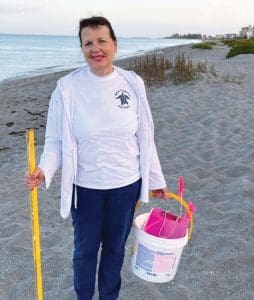We’re not the only species being impacted.


My husband and I have been involved in Sea Turtle Patrol for decades. We walk assigned beaches of southwest Florida to identify and support sea turtle survival. This volunteer honor conveys federal and state responsibilities and regulations related to these charismatic reptiles. The lesson learned—we’re all interconnected.
In the course of doing this work, I’ve learned that the sand’s environment determines the sex of a sea turtle hatchling. Hot sand equals female turtles, and cooler environments result in males. Temperature rise as a result of climate change threatens the species’ survival.
Other data illustrate the interface between humans and nature: respiratory viruses spreading among dolphins, fish, and other marine creatures with human medications in their systems. In other words, our actions affect the fate of these creatures.
According to the National Oceanic and Atmospheric Administration (NOAA), years 2013 through 2021 rank among the 10 warmest on record. In addition, the seventh highest level of ocean heat content (OHC) occurred in the past 7 years and reached a record high in 2021. High OHC can contribute to sea level rise.
This increase in heat also correlates with an increase in mosquitoes and vector-transmission of viruses, including Zika, West Nile, dengue, and viral encephalitis. In addition to mosquito-borne illnesses, tick-borne illness in the United States has more than doubled over the past 20 years, according to the CDC. I have firsthand knowledge of viral encephalitis. While in Connecticut, a mosquito bite landed me in the hospital with a coma for several days. That experience informed my nursing practice and thoughts about healthcare.
For the past 2 years, the United States has experienced very active hurricane seasons, and hurricane forecasters report that we can expect another above-normal season. The warming climate also increases sea-level rise, which creates rainfall patterns with more flooding. We’re beyond denial of this issue. With increased tidal flooding and more frequent “king tides” across the country, some communities have taken proactive steps to address the problem.
Here are some actions you can take that draw from your nursing knowledge and experience.
- Advocate for people you know. For example, before accepting a diagnosis of dementia, request a full workup. Consider the singer Kris Kristofferson, who was diagnosed with a number of conditions, including Alzheimer’s, when he was actually suffering from Lyme disease for years.
- Serve on community committees. Communities value and need your nursing expertise. Nurses look at people holistically and know that foundational knowledge is key to the best health and healthcare.
- Follow local and national legislation and policies. We know that wetlands and barrier islands play important roles in nature. Their destruction may exacerbate climate change impact.
- Write about what you see in your community. For those living on or near the water, the FEMA website (fema.gov) is important. It updates its maps to reflect changing sea levels and warming.
- Volunteer for local emergency management roles. Use your critical thinking and collaboration skills to improve your community and its recovery.
- Read about policy and its impact on our collective lives—people and creatures. The CDC’s Emerging Infectious Diseases podcast episode “Public Willingness to Pay for Mosquito Control, Texas” best illustrates how local decisions impact public health. AN
Tina M. Marrelli, a member of the American Nurse Journal advisory board, is president at Marrelli and Associates, Inc., and chief clinical officer at e-Caregiving.com in Venice, Florida.
For further reading:
To learn more about climate change and its impact on nature and human health, check out these sources.
- Cipriano PF. Climate courage: Act now to protect the global population. myamericannurse.com/climate-change-courage
- Davidson OG. Fire in the Turtle House: The Green Sea Turtle and the Fate of the Ocean. New York, NY: PublicAffairs; 2003.
- Inside Climate News. insideclimatenews.org
- Landhuis E. Detecting Alzheimer’s gets easier with a simple blood test. Scientific American. February 4 2021.
- Piscitelli P, Costa S, Costa A, Emiliano M, et al. Italian Constitution amended to include environmental and health protection. A model for Europe. Lancet Reg Health Eur. 2022;16:100367. doi:10.1016/j.lanepe.2022.100367
- https://www.thelancet.com/journals/lanepe/article/PIIS2666-7762(22)00060-6/fulltext


















